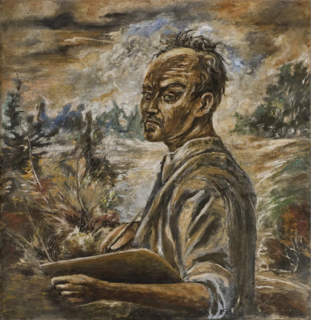 W
WFederico Heraclio Cantú Garza was a Mexican painter, engraver and sculptor. While considered to be a member of the Mexican muralism movement, his style was noticeably different, mostly for adhering to older and more academic forms of painting and sculpture. He had his most success exhibiting in the United States and Europe, but he did murals and sculptures in Mexico. His best known work is a sculpture called La maternidad which was adapted as the logo of the Instituto Mexicano de Seguro Social (IMSS).
 W
WErasto Cortés Juárez was a Mexican artist and a founding member of the Salón de la Plástica Mexicana.
 W
WArturo Estrada Hernández is a Mexican painter, one of a group of Frida Kahlo’s students called “Los Fridos.” Estrada is mostly known for his mural work, which remains faithful to the figurative style and ideology of Mexican muralism. He has created murals in various parts of Mexico in both public and private places, including a 1988 mural found in the Centro Médico metro station in Mexico City. He has also taught classes at the Escuela Nacional de Pintura, Escultura y Grabado "La Esmeralda", where he was a student, since 1948 and continues to give classes there and other venues. He lives in his birthplace: Panindicuaro, Michoacán.
 W
WMagdalena Carmen Frida Kahlo y Calderón was a Mexican painter known for her many portraits, self-portraits, and works inspired by the nature and artifacts of Mexico. Inspired by the country's popular culture, she employed a naïve folk art style to explore questions of identity, postcolonialism, gender, class, and race in Mexican society. Her paintings often had strong autobiographical elements and mixed realism with fantasy. In addition to belonging to the post-revolutionary Mexicayotl movement, which sought to define a Mexican identity, Kahlo has been described as a surrealist or magical realist. She is known for painting about her experience of chronic pain.
 W
WJosé Chávez Morado was a Mexican artist who was associated with the Mexican muralism movement of the 20th century. His generation followed that of Diego Rivera, José Clemente Orozco and David Alfaro Siqueiros. Although Chávez Morado took classes in California and Mexico, he is considered to be mostly self-taught. He experimented with various materials, and was an early user of Italian mosaic in monumental works. His major works include murals at the Ciudad Universitaria, Secretaría de Comunicaciones y Transportes and Museo Nacional de Antropología in Mexico City as well as frescos at the Alhóndiga de Granaditas, which took twelve years to paint. From the 1940s on, he also worked as a cultural promoter, establishing a number of cultural institutions especially in his home state of Guanajuato including the Museo de Arte Olga Costa - José Chávez Morado, named after himself and his wife, artist Olga Costa.
 W
WDiego María de la Concepción Juan Nepomuceno Estanislao de la Rivera y Barrientos Acosta y Rodríguez, known as Diego Rivera, was a prominent Mexican painter. His large frescoes helped establish the mural movement in Mexican and international art.
 W
WGustav Waldemar Sjölander Johnson was a Swedish painter, printmaker and sculptor, who developed most of his career in Mexico. He immigrated to the country just after World War II, after establishing himself as an artist in his native Sweden. His career included individual exhibitions in venues such as the Palacio de Bellas Artes in Mexico and the Konstakademin in Sweden, with his works held by museums in Mexico and Europe.
 W
WJuan Soriano was a Mexican artist known for his paintings, sculptures and theater work. He was a child prodigy whose career began early as did his fame with various writers authoring works about him. He exhibited in the United States and Europe as well as major venues in Mexico such as the Museo de Arte Moderno and the Palacio de Bellas Artes. His monumental sculptures can be found in various parts of Mexico and in Europe as well. Recognitions of his work include Mexico's National Art Prize, the Chevalier des Arts et Lettres and membership in France's Legion of Honour.
 W
WAlfredo Zalce Torres was a Mexican artist and contemporary of Diego Rivera, David Siqueiros and other better-known muralists. He worked principally as a painter, sculptor, and engraver, also taught, and was involved in the foundation of a number of institutions of culture and education. He is perhaps best known for his mural painting, typically imbued with "fervent social criticism". He is acclaimed as the first artist to borrow the traditional material of coloured cement as the medium for a "modern work of art". Publicity-shy, he is said to have turned down Mexico's Premio Nacional de Ciencias y Artes before finally accepting it in 2001. Before his death, Sotheby's described him as "the most important living Mexican artist up to date".
 W
WJosé Jesús Francisco Zúñiga Chavarría was a Costa Rican-born Mexican artist, known both for his painting and his sculpture. Journalist Fernando González Gortázar lists Zúñiga as one of the 100 most notable Mexicans of the 20th century, while the Encyclopædia Britannica calls him "perhaps the best sculptor" of the Mexican political modern style.